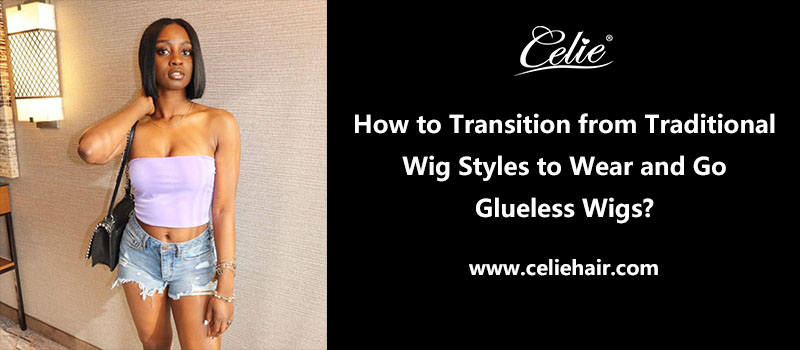Wigs have been a staple in the world of fashion and beauty for centuries, allowing individuals to transform their looks with ease. Traditional wig styles have often required the use of adhesives, tapes, or sewing to securely attach them to the scalp. However, with the advancement of technology and innovation in the wig industry, the emergence of glueless wigs has revolutionized the way people wear wigs. Glueless wigs, also known as “wear and go” wigs, offer convenience, comfort, and a natural appearance without the need for adhesive products. In this comprehensive guide, we will explore the process of transitioning from traditional wig styles to wearing glueless wigs, providing step-by-step instructions, tips, and insights to ensure a seamless experience.

A brief history of traditional wigs and the evolution to glueless wigs.
Wigs have a rich history that spans cultures and centuries, evolving from symbols of status and fashion statements to innovative solutions for various needs. Traditional wigs and glueless wigs represent two distinct phases in the evolution of hairpieces, each with its own unique significance and impact on the world of fashion and beauty.
Traditional wigs: A historical perspective.
The use of wigs dates back thousands of years to ancient civilizations like Egypt, where wigs were donned by both men and women as symbols of social status and religious significance. In Europe, wigs became popular during the Renaissance era, with elaborate styles and powdered hair becoming a hallmark of aristocracy. Wigs were not only worn for aesthetic reasons but also to conceal hair loss due to medical conditions such as syphilis.
Throughout the 17th and 18th centuries, wigs continued to evolve in style and purpose. In the 18th century, wigs became a staple of formal wear in European courts, and intricate designs became a reflection of one’s wealth and social standing. However, the popularity of wigs waned during the French Revolution as a symbol of excess and elitism.
Transition to glueless wigs: A modern innovation.
The transition from traditional wigs to glueless wigs is a testament to the ever-evolving nature of fashion, technology, and personal preferences. While traditional wigs required adhesives, tapes, and sometimes even sewing to secure them to the scalp, the desire for convenience, comfort, and a natural look paved the way for the emergence of glueless wigs.
The turning point in wig technology came with the development of lace front wigs. These wigs featured a fine lace material at the front hairline, giving the illusion of natural hair growth and allowing wearers to style their hair away from the face. This innovation significantly improved the natural appearance of wigs.
Glueless wigs, also known as “wear and go” wigs, took this concept further by integrating adjustable straps, combs, and elastic bands within the wig cap. These features eliminated the need for adhesives while providing a secure fit. As a result, individuals could enjoy the benefits of wigs without the discomfort and potential skin issues associated with glue or tape.
Glueless wigs quickly gained popularity due to their convenience and versatility. People could change their hairstyles with ease, whether they wanted a new look for a special occasion or an everyday change. Additionally, the development of high-quality human hair made glueless wigs more affordable and accessible to a wider audience.
Preparing for the transition.
Assess your needs.
Before making the transition to glueless wigs, it’s essential to assess your lifestyle, preferences, and goals. Consider factors such as your desired wig style, frequency of wear, and comfort level.
Selecting the right glueless wig.
When choosing a glueless wig, factors such as hair type (human hair or synthetic), wig cap construction (lace front, full lace, or 360 lace), hair length, and color should be considered. Opt for a wig that complements your natural features and aligns with your style preferences.
Transitioning process.
Proper hair preparation.
To achieve the best results with glueless wigs, it’s important to prepare your natural hair appropriately. Start by washing and conditioning your hair, ensuring that it’s clean and well-moisturized. If your natural hair is longer, consider braiding or twisting it to create a smooth base for wig application.
Applying a wig cap.
Wearing a wig cap is essential to create a secure foundation for your glueless wig. Choose a wig cap that matches your skin tone and fits comfortably on your head. Stretch the cap over your braided or twisted hair and secure it in place.
Adjusting the wig.
Place the glueless wig on your head and adjust its position to align with your natural hairline. Most glueless wigs come with adjustable straps or combs that can be used to secure the wig in place. Make sure the wig is snug but not too tight to avoid discomfort.
Styling your glueless wig.
One of the advantages of glueless wigs is the freedom to style them according to your preferences. Use heat styling tools, curlers, or flat irons to achieve various looks. However, be cautious with excessive heat application, as it can damage synthetic wigs.
Caring for your glueless wig.
Regular cleaning.
Proper maintenance is crucial to prolong the lifespan of your glueless wig. Follow the manufacturer’s guidelines for washing and conditioning. For synthetic wigs, use specialized wig care products to maintain the wig’s texture and color.
Storage.
When not in use, store your glueless wig on a wig stand or mannequin to maintain its shape and prevent tangling. Keep it away from direct sunlight and heat sources to prevent damage.
Handling.
Gently comb or brush your wig to detangle any knots or snarls. Start from the ends and work your way up to prevent excessive shedding. Be mindful of the wig’s delicate construction while handling it.
Tips for a smooth transition.
Gradual transition.
If you’re new to glueless wigs, consider transitioning gradually. Start by wearing the glueless wig for shorter periods and gradually increase the duration as you become more comfortable.
Professional assistance.
If you’re unsure about the transition process, seek guidance from a professional hairstylist or wig specialist. They can provide personalized recommendations based on your needs and preferences.
Experiment with styles.
Take advantage of the versatility of glueless wigs by experimenting with different styles, colors, and textures. Embrace the opportunity to change your look effortlessly.
Key features:
Pre-bleached knots for an authentic and realistic appearance.
Air cap design for a comfortable and breathable experience.
Straight bob style for a timeless and sophisticated look.
Pre-cut 5×5 HD lace for a flawless blend with your skin.
180% hair density for added volume and lushness.
No need for adhesives, offering ease of wear and removal.

In summary.
Transitioning from traditional wig styles to glueless wigs offers a range of benefits, from convenience and comfort to versatility and a natural appearance. By following the steps outlined in this comprehensive guide, you can make a seamless switch to wearing and enjoying glueless wigs. Remember to select the right wig for your needs, properly prepare your natural hair, and care for your wig to ensure its longevity and continued stunning appearance. With the freedom to style and wear your wig with ease, you’ll discover a new level of confidence and self-expression.
















